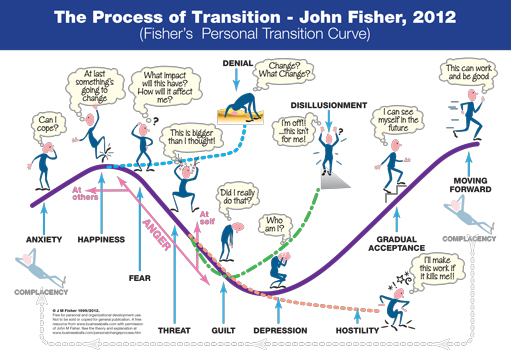4 Resilience and change
One way of thinking about career and personal resilience is that developing resilience leads to success in dealing with change.
Psychologist John Fisher has developed a model of personal change – the Personal Transition Curve (see Figure 2) – through work that examines how individuals respond to changes being made within their organisations. Fisher’s work is based on, and advances, earlier work in psychology dating back to Elisabeth Kübler-Ross’s work on death, loss and grief in 1973.
Fisher identifies eight stages of personal transition in response to change in the workplace, ranging from ‘anxiety’ to ultimately ‘moving forward’ – although not all stages are of equal length or significance for each person, even within the same changing organisation.

He also identifies three further ‘points’ where people may get stuck, rather than moving through the transition process. These are ‘denial’ of or ‘hostility’ towards change, and ‘disillusionment’ – where someone may decide that they will leave the organisation. ‘Complacency’ is another element that can run throughout the process.
The transition phases represent a sequence in your levels of self-esteem as you experience change. These changes in self-esteem appear to follow a predictable path, so identifying the eight phases can help you to understand the transition process better.
Although this model describes transition as a sequence, not everyone in job transition will experience every phase. Each person’s progress is unique: one may never get beyond denial or disillusionment; another may drop out during the depression phase; others will move smoothly and rapidly to the later phases.
You’ll explore self-esteem and its contribution to career resilience in more detail in Weeks 5 and 6.
In the next activity, you’ll consider an occasion where you faced change, and try to plot your own transition curve.
Activity 7 Personal transition curve
Using Fisher’s Personal Transition Curve in Figure 2, and the personal example of change that you identified in Activity 5, think about whether you recognise any of the stages listed here. Make some notes about your own transition curve.
Do you remember experiencing these stages? How long did it take to make the change?
Did you move quickly through the cycle or get stuck?
If you got stuck in ‘denial’ or ‘hostility’, or even ‘disillusionment’ – think about what you could have done to take care of yourself when going through the different stages. For example, talking to others, taking action, focusing on a new activity outside work, etc. Maybe you experienced a successful transition because you did some of these things.
Comment
If you found this a challenging activity, the thought bubbles used in the Personal Transition curve diagram can be a useful way to think about your own experience – varying from ‘Can I cope?’ (anxiety) to ‘Did I really do that?’ (guilt) and ‘This can work and be good’ (moving forward).
By looking back at previous experiences of change and analysing them in this way – you can gain insight into how you and/or your employer deal with change and perhaps make the next experience a more positive one.
